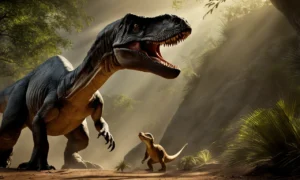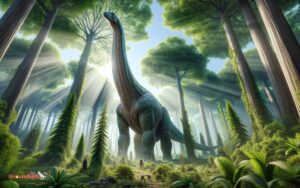Where Can You Go to See Dinosaurs
At the Royal Tyrrell Museum in Canada, visitors can marvel at one of the world's largest displays of dinosaurs, showcasing the rich history of the Mesozoic Era. This museum serves as a prime example of how enthusiasts can immerse themselves in the ancient world of these magnificent creatures.
However, the journey doesn't end there. Across the globe, from the deserts of North America to the rich landscapes of Asia, numerous sites and museums offer a glimpse into the past, where dinosaurs ruled the earth. Each location provides a unique window into prehistoric life, beckoning those curious enough to explore further.
Key Takeaways
- Visit the Morrison Formation in the Western US to explore the Late Jurassic era.
- The Hell Creek Formation offers a glimpse into the Cretaceous-Paleogene boundary.
- European museums, like the Natural History Museum in London, showcase iconic dinosaur fossils.
- Asia's fossil sites reveal diverse dinosaur species, enhancing our understanding of their evolutionary history.
The Mesozoic Era Unveiled
Delving into the Mesozoic Era, it's essential to understand that this period, spanning approximately 252 to 66 million years ago, marks a profound evolutionary explosion of dinosaurs, setting the stage for their dominance across diverse ecosystems.
This era, divided into the Triassic, Jurassic, and Cretaceous periods, witnessed the emergence and extinction of numerous dinosaur species. Researchers meticulously analyze fossil records to decode the era's climatic conditions, flora, and fauna dynamics, offering insights into the evolutionary pathways that led to the rise of dinosaurs.
The Mesozoic's rich biodiversity underscores a critical phase in Earth's history, where tectonic movements, climate shifts, and ecological interactions shaped the evolutionary trajectory of life, culminating in the dominance of dinosaurs that continues to captivate the scientific community and general public alike.
North America's Fossil Sites
Exploring North America's fossil sites reveals a tapestry of ancient life, where the remnants of the Mesozoic era's dinosaurs offer unparalleled insights into their existence and environments. These sites function as natural archives, each layer of sediment a page in Earth's history, meticulously chronicling the evolutionary journey of these magnificent creatures.
The Morrison Formation, stretching across the Western United States, stands as a testament to the rich biodiversity of the Late Jurassic period, housing an extensive collection of sauropod fossils. Similarly, the Hell Creek Formation provides a vivid snapshot of the Cretaceous-Paleogene boundary, offering critical evidence of the catastrophic event that led to the mass extinction of dinosaurs.
These fossil sites not only illuminate the past but also serve as crucial resources for scientific research, enhancing our understanding of ancient ecosystems and evolutionary processes.
Europe's Dinosaur Museums
Shifting our focus across the Atlantic, Europe's dinosaur museums emerge as pivotal destinations for understanding the continent's prehistoric life through meticulously curated collections and exhibits. These institutions serve not only as custodians of history but also as research centers where scientists and scholars delve into the depths of prehistoric eras, unearthing insights that challenge and refine our understanding of dinosaur evolution and extinction.
Each museum, from the renowned Natural History Museum in London with its iconic Diplodocus cast to the lesser-known but equally fascinating Museo Paleontologico in Italy, offers a unique lens through which to view the ancient past. Europe's rich geological history, marked by dramatic shifts and transformations, is encapsulated within these institutions, providing a comprehensive, scholarly exploration of the dinosaurs that once roamed this diverse continent.
Asia's Prehistoric Highlights
Asia's prehistoric landscape, rich in diversity and complexity, offers a treasure trove of insights into the dinosaurs that once dominated its vast terrains. The continent's contribution to paleontology can't be understated, with numerous sites providing critical data on various dinosaur species.
This scientific wealth is attributed to several factors:
- Extensive fossil beds: Asia hosts some of the most significant fossil deposits, revealing diverse dinosaur species.
- Varied climates and ecosystems: These facilitated the preservation of a wide range of dinosaur remains.
- Active paleontological research: Asian countries have invested in dinosaur research, uncovering new species and insights.
- Public interest and educational value: There's a growing interest in dinosaurs in Asia, promoting conservation and study.
These elements combine to position Asia as a pivotal region for understanding dinosaurs' evolutionary history and ecological impact.
South America's Dinosaur Trails
South America's contribution to paleontological research is significantly marked by its dinosaur trails, notably in Patagonia and what's colloquially known as Argentina's Jurassic Park.
Patagonia's rugged landscapes are a treasure trove of fossilized remains, offering insights into prehistoric life that roamed this part of the continent millions of years ago.
Meanwhile, Argentina's Jurassic Park stands as a pivotal site for understanding the diversity and evolution of Jurassic-era dinosaurs, providing a rich field for scientific study and public fascination.
Patagonia's Fossil Treasures
Nestled within the rugged landscapes of Patagonia, a treasure trove of dinosaur fossils offers unparalleled insights into prehistoric life in South America. This region's significance lies not only in the volume of discoveries but in their diversity and preservation, providing a unique window into the Mesozoic era.
Key aspects of Patagonia's fossil treasures include:
- Exceptionally well-preserved specimens that allow for detailed paleontological studies.
- A wide range of species, highlighting the diverse dinosaur fauna of the Cretaceous period.
- Evidence of prehistoric ecosystems, offering clues about ancient climates and environments.
- The discovery of some of the largest dinosaurs ever found, shedding light on sauropod gigantism.
Patagonia's contribution to our understanding of dinosaur evolution and ecology is immense, making it an essential area for paleontological research and education.
Argentina's Jurassic Park
In the heart of Argentina lies a region often dubbed as Jurassic Park, a testament to its rich collection of dinosaur fossils that trace back to the Mesozoic era. This locale, distinguished by its paleontological significance, offers an unparalleled window into prehistoric life.
Scholars and enthusiasts alike are drawn to its sedimentary layers, which meticulously preserve the remains of colossal creatures that once roamed Earth. The meticulous excavation and analysis conducted in this area have led to groundbreaking discoveries, further solidifying its status as a pivotal site for understanding dinosaur evolution and biodiversity.
Notably, the findings contribute to the global scientific community's knowledge, challenging and refining existing theories about dinosaur behavior, ecology, and their eventual extinction. Argentina's Jurassic Park thus stands as a crucial nexus for paleontological research and education.
Africa's Ancient Discoveries
Africa's rich tapestry of geological history has yielded remarkable discoveries of dinosaur fossils, underscoring the continent's pivotal role in our understanding of prehistoric life. These findings not only enhance our comprehension of dinosaur evolution but also highlight Africa's unique contribution to paleontology. The continent's diverse climatic and geographical landscapes have preserved a wide range of fossil records, offering insights into the mesozoic era.
Key discoveries include:
- *Spinosaurus* in North Africa, suggesting semi-aquatic lifestyles.
- *Suchomimus* resembling modern crocodilians, indicating a diverse predatory landscape.
- *Paralititan* in Egypt, one of the largest dinosaurs, highlighting the existence of colossal herbivores.
- *Aardonyx*, shedding light on the transition from bipedal to quadrupedal locomotion.
These findings underscore Africa's integral role in the mosaic of dinosaur evolution, providing a comprehensive view of their existence and adaptation over millions of years.
Conclusion
In conclusion, the quest to witness the majesty of dinosaurs leads adventurers through a global tapestry of ancient landscapes. From North America's fossil-rich badlands to Europe's curated museum halls, Asia's prehistoric highlights, South America's vast dinosaur trails, and Africa's cradle of ancient discoveries, each region offers a unique window into the Mesozoic Era.
Amid these journeys, one encounters a poignant anachronism: the silent whispers of a bygone world, echoing the impermanence of life and the relentless march of time.




